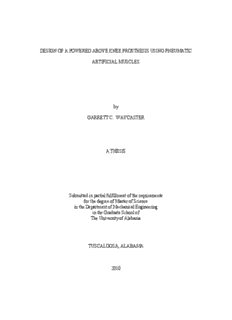
DESIGN OF A POWERED ABOVE KNEE PROSTHESIS - acumen PDF
Preview DESIGN OF A POWERED ABOVE KNEE PROSTHESIS - acumen
DESIGN OF A POWERED ABOVE KNEE PROSTHESIS USING PNEUMATIC ARTIFICIAL MUSCLES by GARRETT C. WAYCASTER A THESIS Submitted in partial fulfillment of the requirements for the degree of Master of Science in the Department of Mechanical Engineering in the Graduate School of The University of Alabama TUSCALOOSA, ALABAMA 2010 Copyright Garrett Clinton Waycaster 2010 ALL RIGHTS RESERVED ABSTRACT This paper describes the mechanical design for both a one and two degree of freedom above-knee (AK) prosthesis actuated by pneumatic artificial muscles. Powered prosthetics aim to improve the quality of life of the 50% of AK amputees who never regain the ability to walk. Pneumatic artificial muscle (PAM) provides great potential in prosthetics, since this type of actuator features a high power density and similar characteristics to human muscles. Currently, commercially available AK prosthetics are largely passive devices, and no research has been conducted on PAM actuators in AK prosthetics. In this thesis, the design requirements of an above knee prosthesis using PAM are discussed and a prototype one degree of freedom prosthesis with a PAM actuated knee joint is constructed. This prototype is then tested, and based on the results a new actuator is developed. This new actuator uses a flexible tendon and an elliptical pulley to improve torque, adding more functionality and increasing the maximum mass of a user by 25 kilograms. This actuator is also tested and compared to the initial prototype design. Finally, this new actuator is incorporated into the design of a two degree of freedom prosthesis with an actuated ankle as well as the knee joint. ii DEDICATION To my wife, Lauren Thank you for your love, support, and guidance iii LIST OF ACRONYMS AND SYMBOLS Ellipse Semi-major Diameter 𝑎𝑑𝑖𝑎 Ellipse Semi-minor Diameter 𝑏𝑑 𝑖𝑎 Force 𝐹 Slider Crank Actuator Fixed Point x Coordinate 𝐿0 Slider Crank Actuator Fixed Point y Coordinate 𝐿1 Line Slope 𝑚 Pulley Radius 𝑟 Radial Coordinate of Pulley Center 𝑟0 Effective Radius 𝑟𝑒𝑓𝑓 Actual Torque Output 𝑇𝑎𝑐𝑡 Required Torque Output 𝑇𝑟𝑒𝑞 Pulley Muscle Fixed Point Relative x-axis Position 𝑥0 Pulley Muscle Fixed Point Relative y-axis Position Greek L𝑦e0tters Change in Knee Rotation Angle ∆γ 𝛾 Knee Rotation Angle Angular Coordinate of Pulley Radius 𝜃 Angular Coordinate of Pulley Center 𝜃φ0 Ellipse Rotation iv Acronyms AK Above Knee DOF Degree of Freedom PAM Pneumatic Artificial Muscle TBM Total Body Mass v ACKNOWLEDGMENTS I would especially like to thank Dr. Xiangrong Shen for providing me with the opportunity to work on this project, and for his help and support along the way. I would also like to thank Dr. Beth Todd, Dr. Keith Williams, and Dr. Mark Richardson for their assistance as part of my thesis committee. I would like to thank the Graduate Council and the Mechanical Engineering department for their financial support during my graduate study. Additionally I would like to thank the Graduate Student Association for their financial support for my research work. Finally, I would like to thank my fellow students, Daniel Christ, Alston Pike, and Marco Wu, for their discussion, hard work, and encouragement in association with this project. vi CONTENTS ABSTRACT .................................................................................................................................... ii LIST OF ACRONYMS AND SYMBOLS .................................................................................... iv ACKNOWLEDGMENTS ............................................................................................................. vi LIST OF TABLES ...........................................................................................................................x LIST OF FIGURES ....................................................................................................................... xi CHAPTER 1: INTRODUCTION ....................................................................................................1 1.1 Motivation ..............................................................................................................................1 1.2 Objective ................................................................................................................................2 1.3 Organization of the Thesis .....................................................................................................2 CHAPTER 2: BACKGROUND AND LITERATURE REVIEW ..................................................4 2.1 Current Commercial Prosthetics ............................................................................................4 2.2 Current Prosthetics Research .................................................................................................8 2.3 Pneumatic Artificial Muscles ...............................................................................................11 CHAPTER 3: DESIGN REQUIREMENTS OF A TRANSFEMORAL PROSTHESIS ..............15 3.1 Introduction to Gait and Prosthetics Design ........................................................................15 3.2 Torque Requirements of a Prosthesis ..................................................................................16 3.3 Anthropometric Requirements of a Prosthesis ....................................................................16 vii CHAPTER 4: DESIGN AND TESTING OF A ONE DOF PROSTHESIS .................................21 4.1 Conceptual Design ...............................................................................................................21 4.2 Control .................................................................................................................................26 4.3 Testing..................................................................................................................................27 CHAPTER 5: NOVEL ACTUATOR DESIGN ............................................................................28 5.1 Justification for New Actuator Design ................................................................................28 5.2 Comparison of Feasible Options for Actuation ...................................................................28 5.3 Optimization Theory and Practice .......................................................................................32 5.4 Constant Radius Pulley Optimization ..................................................................................36 5.5 Slider Crank Actuator Optimization ....................................................................................36 5.6 Elliptical Actuator Optimization ..........................................................................................37 5.7 Comparison of Actuation Methods ......................................................................................40 5.8 Construction and Testing .....................................................................................................45 CHAPTER 6: TWO DOF PROSTHESIS CONCEPTUAL DESIGN ..........................................48 6.1 Introduction to Two DOF Prosthesis ...................................................................................48 6.2 Component Configuration ...................................................................................................49 CHAPTER 7: CONCLUSION AND FUTURE WORK ...............................................................52 7.1 Future Work .........................................................................................................................52 7.2 Conclusions ..........................................................................................................................53 viii Appendix A – Part Drawings .........................................................................................................54 Appendix B – Optimization Code..................................................................................................85 Bibliography ................................................................................................................................115 ix
Description: